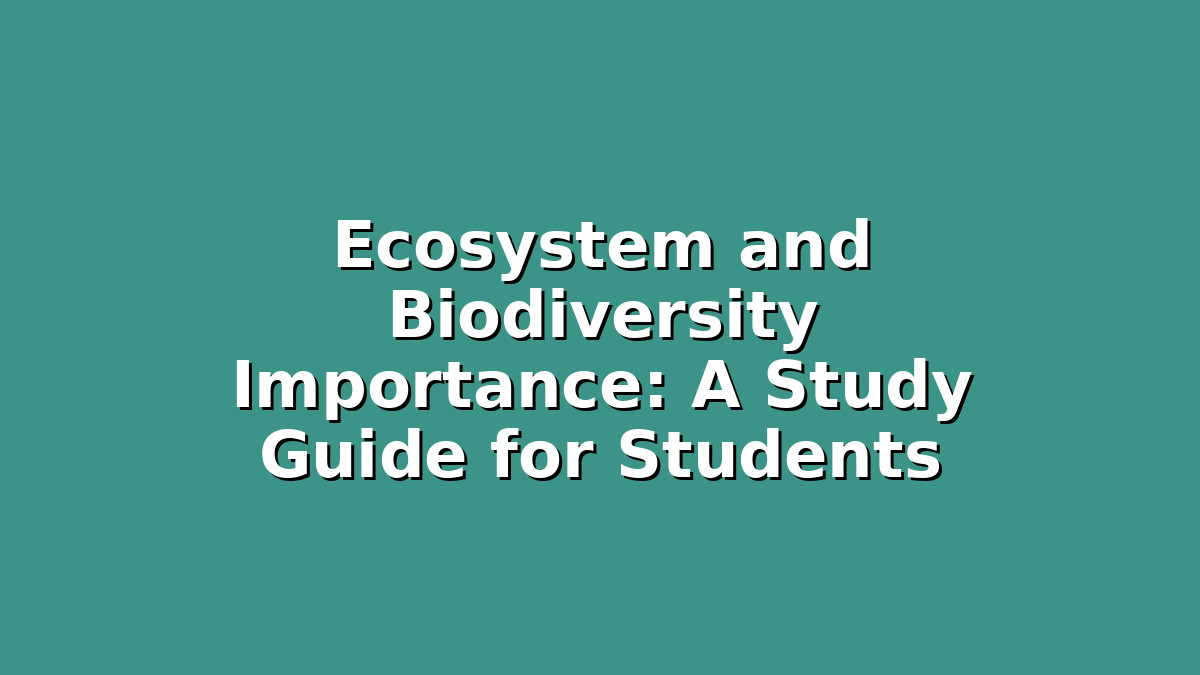Introduction
As a student preparing for exams, you often come across topics that are both fascinating and crucial for understanding the natural world. One such topic is the ecosystem and biodiversity importance. These concepts are foundational in environmental science, biology, geography, and even social studies. Understanding ecosystems and biodiversity not only helps you excel in exams but also builds awareness about the environment, encouraging responsible stewardship of our planet.
This article will help you grasp the importance of ecosystems and biodiversity by breaking down key ideas into manageable sections. Additionally, we’ll share study-related tips to make your learning efficient and effective. Whether you’re studying for a biology exam, preparing a project, or just curious, this guide will support your learning journey.
Section 1: Understanding Ecosystems – What They Are and Why They Matter
An ecosystem is a community of living organisms interacting with each other and their physical environment. It includes plants, animals, microorganisms, water, soil, and climate. Ecosystems can be small, like a pond, or large, like a rainforest or ocean. Each part of the ecosystem plays a specific role, creating a balanced network that sustains life.
Why are ecosystems important? They provide essential services that humans and other living beings depend on:
– Provisioning services: These include food, fresh water, timber, and medicine that ecosystems supply.
– Regulating services: Ecosystems help regulate climate, control floods, and purify air and water.
– Supporting services: They maintain soil fertility, enable nutrient cycling, and support plant growth.
– Cultural services: Many communities derive cultural, spiritual, and recreational benefits from ecosystems.
Study Tip: When learning about ecosystems, create diagrams to visualize interactions between different components like producers, consumers, and decomposers. Use color codes or symbols to represent energy flow and nutrient cycles. Visual aids help reinforce memory and make complex information easier to recall.
Section 2: Biodiversity – The Variety of Life and Its Significance
Biodiversity refers to the variety of life on Earth, including species diversity (different types of plants, animals, fungi, bacteria), genetic diversity (variations within species), and ecosystem diversity (different habitats and ecological processes). It is often called the “web of life” because all living organisms are connected in some way.
The importance of biodiversity includes:
– Ecosystem resilience: Diverse ecosystems are better at withstanding disturbances like natural disasters or human impact.
– Health benefits: Many medicines are derived from plant and animal species, and genetic diversity helps develop disease-resistant crops.
– Economic value: Biodiversity supports agriculture, fisheries, tourism, and other industries.
– Moral and aesthetic value: Many people believe all species have the right to exist, and biodiversity enriches human experience with its beauty and complexity.
Study Tip: To remember biodiversity concepts, try creating flashcards with definitions, examples, and significance. Group species or ecosystems by categories such as endangered, endemic, or keystone species. This method breaks down information into bite-sized pieces, making revision less overwhelming.
Section 3: Linking Ecosystems, Biodiversity, and Your Exam Preparation
Understanding the link between ecosystems and biodiversity is essential, especially for exams that test your ability to analyze environmental issues or suggest conservation methods.
– Cause and effect: Learn how loss of biodiversity can disrupt ecosystems and how ecosystem degradation threatens biodiversity.
– Real-world examples: Study famous ecosystems like the Amazon rainforest, coral reefs, or wetlands, focusing on their biodiversity and threats they face.
– Conservation strategies: Understand methods such as protected areas, sustainable resource management, and restoration ecology.
Study Tip: Practice answering past exam questions or writing short essays on ecosystem-biodiversity topics. Use the “PEEL” method (Point, Evidence, Explanation, Link) to structure your answers clearly. Also, form study groups to discuss these topics – teaching others can strengthen your own understanding.
Conclusion
Ecosystems and biodiversity are deeply interconnected and vital to the planet’s health and human well-being. For students, mastering these concepts opens doors to better exam performance and a broader understanding of environmental challenges. By using study techniques like visualization, flashcards, and active practice, you can make learning about ecosystems and biodiversity both effective and enjoyable.
Remember, your efforts today prepare you not only for exams but also for becoming informed citizens who appreciate and protect the natural world.
Keep studying, stay curious, and good luck with your exams!

Responses